Today I show you the two methods I use to condition flowers to extend their vase life by a couple of days. These same methods will also revive wilted flowers.

I was at the garden the other night and I had cut a huge handful of unopened poppies to bring to Betty because I am an excellent daughter.
As I was on my way out of the garden, I stopped and talked to another gardener about garlic, and then another about cucumber beetles, and then another about cucumber beetles and then another about cucumber beetles.
By the time the poppies and I got to Betty's they were looking as limp and exhausted as anyone would be after talking about cucumber beetles for an hour.
As soon as I got to Betty's I implemented the first method of flower reviving and by the next day her limp spaghetti poppies looked like this.
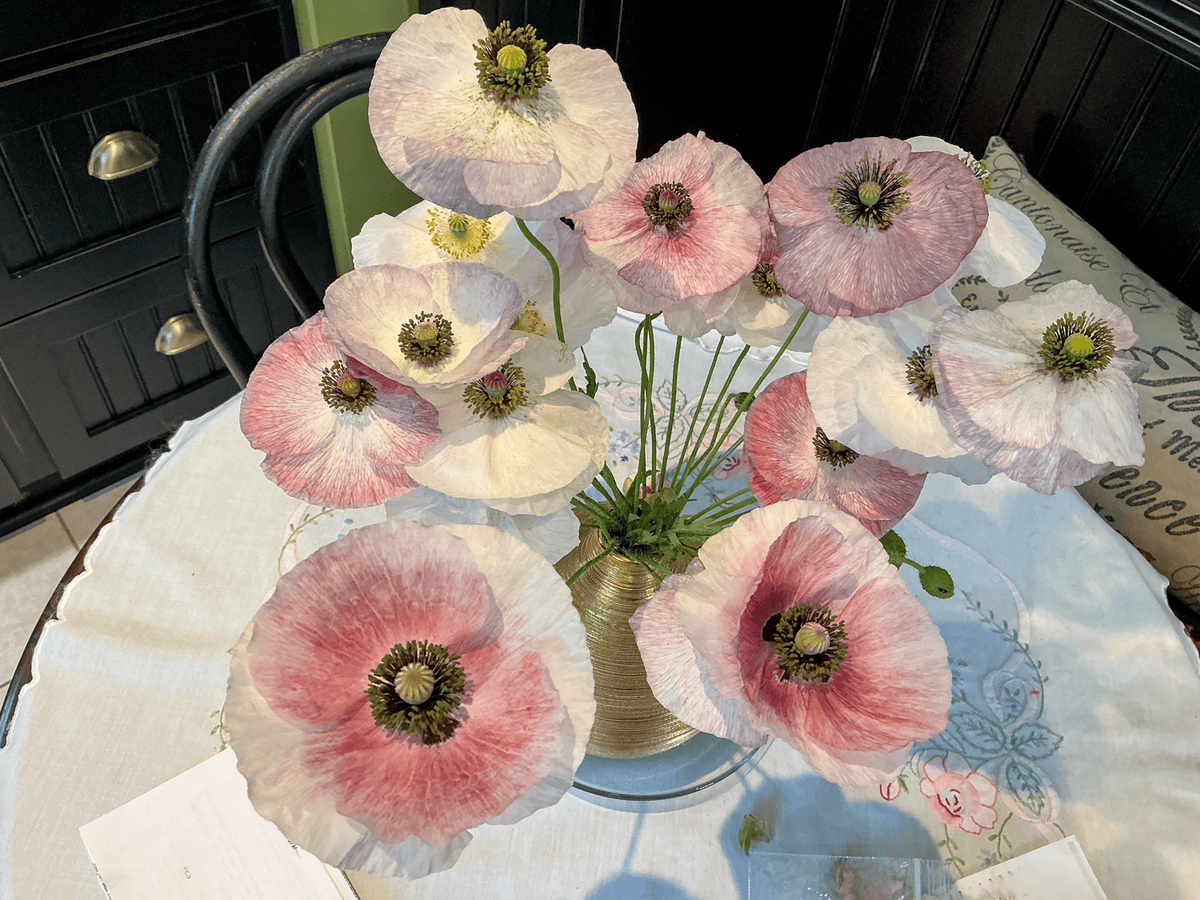
Table of Contents
How to Revive Flowers
Method 1 - Hot Water
The hot water treatment does a great job of getting rid of air that's made its way into the stem.


1. Get the kettle boiling and fill a very clean heat resistant container with boiling water. (any dirt in the container can make its way into the stem clogging it even more.
2. Wrap paper around the stem of the hydrangea to protect the flower from the hot steam. This only needs to be done if the stem isn't long enough to keep the flower tipped to the side and away from the steam and heat of the water.
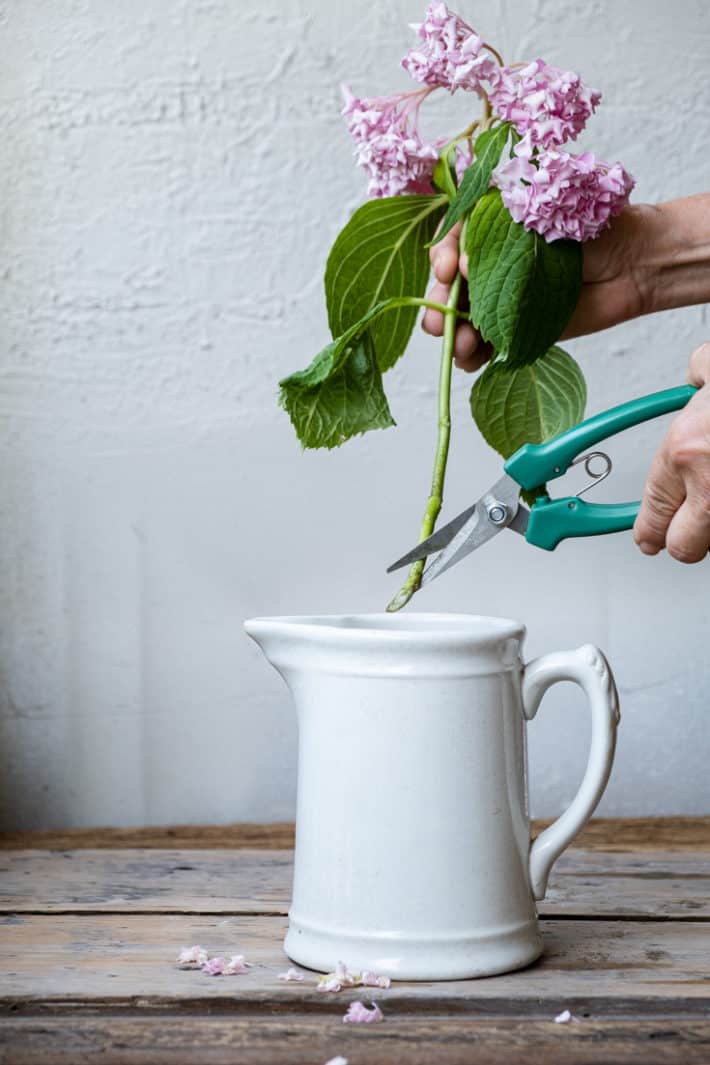
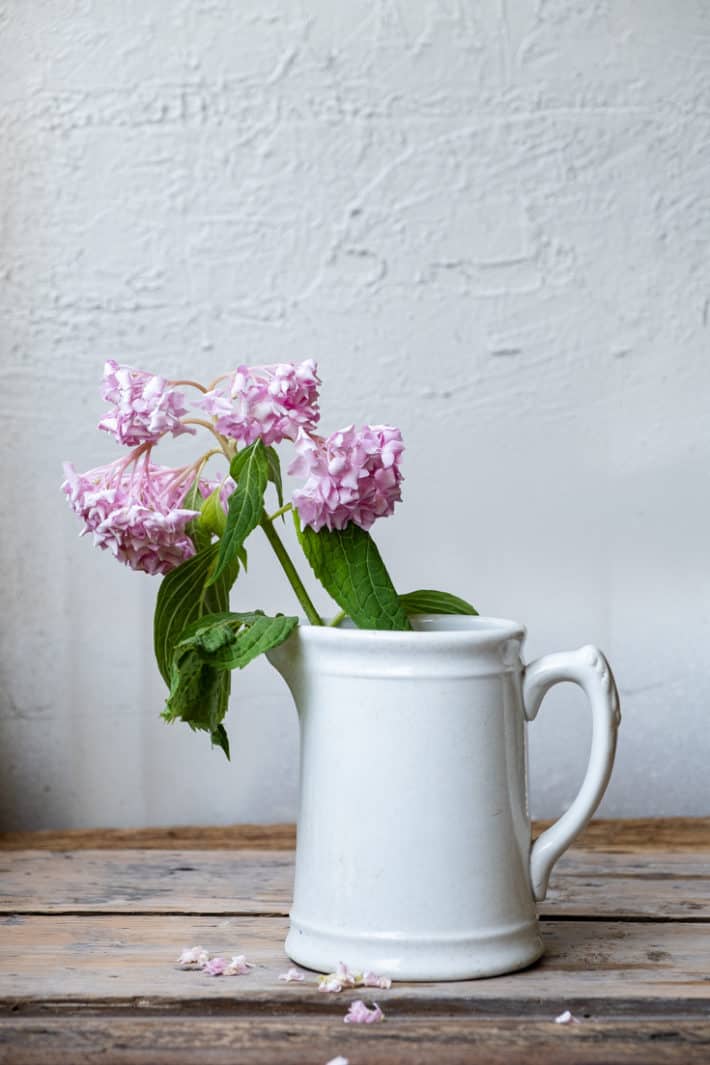
3. Cut about an inch off the end of the stem and immediately plunge the stem into the hot water.
4. Let it sit for as long as it takes for the flower to refresh. Usually around 3 hours but I tend to do this overnight. See that last set of leaves touching the jug? I forgot to remove those immediately and did so right after I took the photo.
** remove extra leaves so they don't hog all the water**
5. In the morning, or after the water has cooled your flower will be revived and you can put your hydrangea into clean cool water.
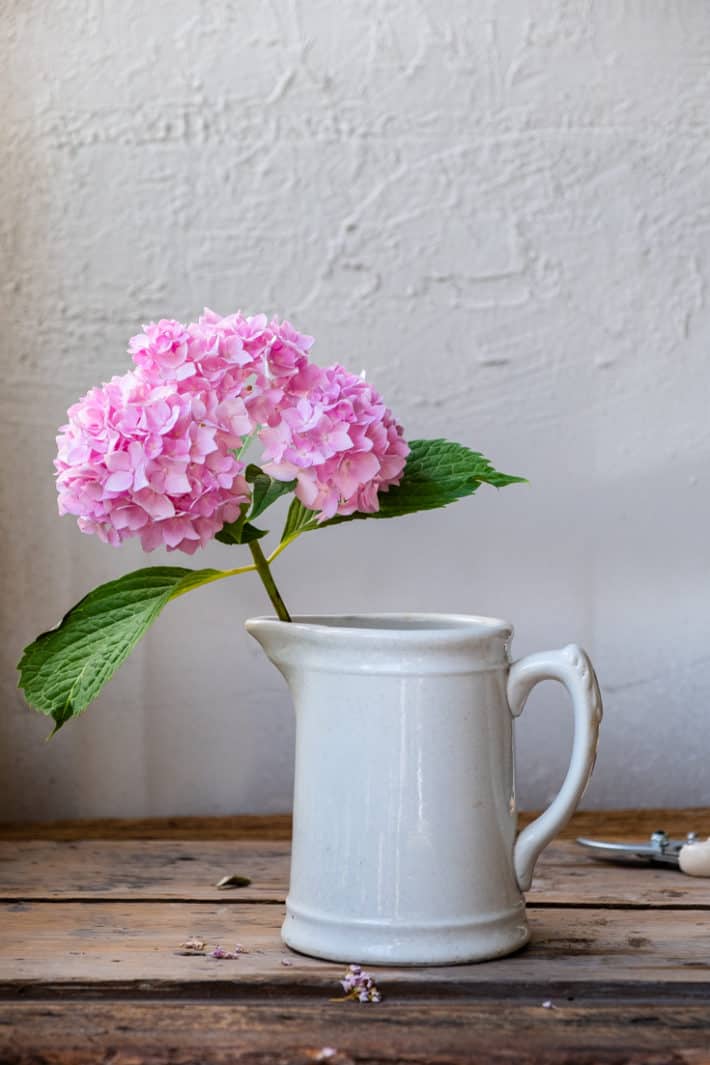
Seriously.
Method 2 - The Water Bath
Submerging flowers completely in water is another really effective way to revive or increase the vase life of any flowers.
- Fill your tub or large sink with warm water and lay the flowers down. Leave them overnight or for several hours.
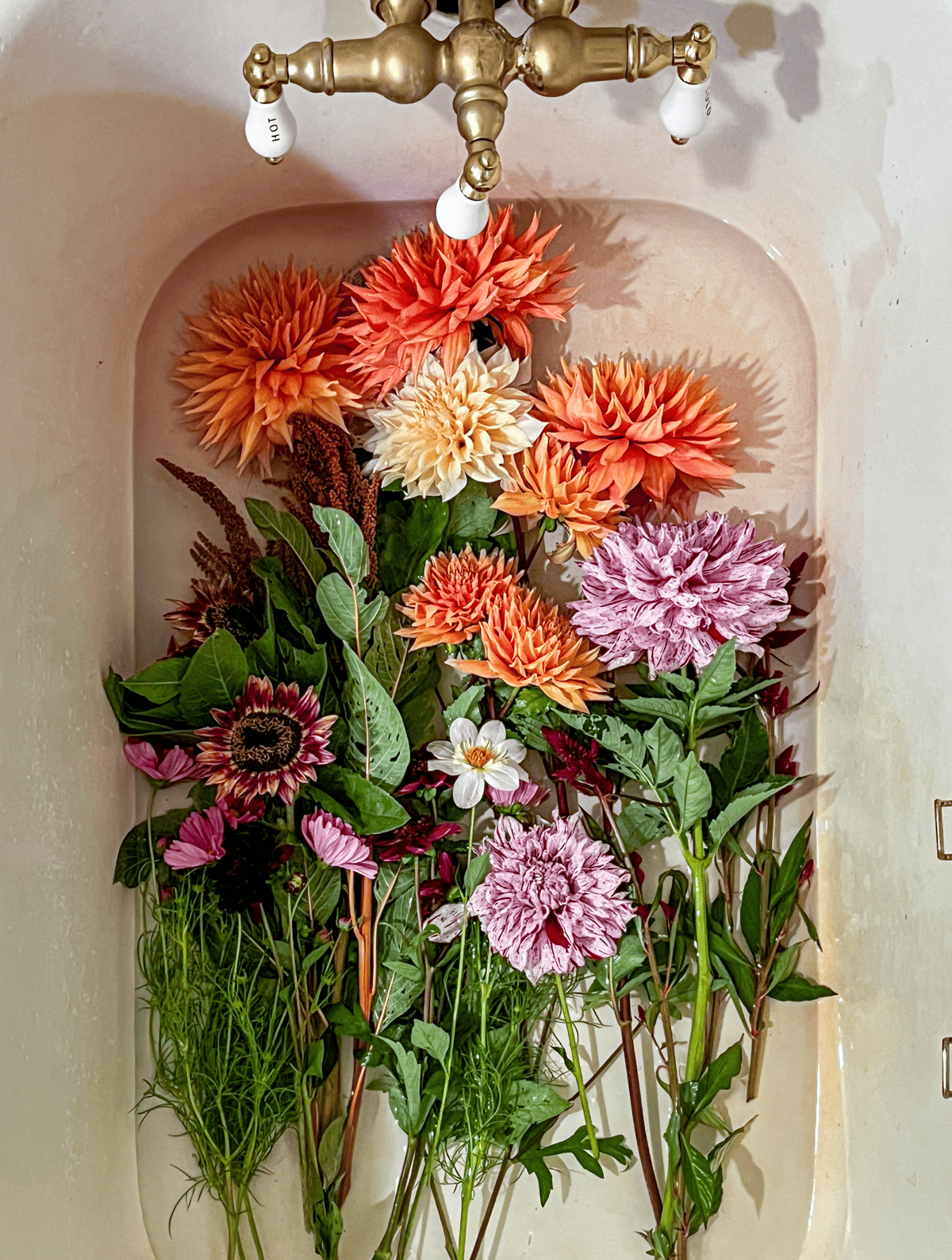
This method is better when you have huge amounts of flowers. It works because it allows the flowers to hydrate quickly using their stems, petals and leaves to take in water.
Giving flowers a water bath immediately after cutting will increase their vase life.
What Causes Flowers to Wilt?
If a newly cut flower wilts within a day or two or even by the time you bring it home, it's because it was out of water and air has made its way into the stem. Those air bubbles prevent the stem from sucking up water to the bloom.
THIS is why you always read that you should cut stems under water. So no air gets in the stems.
Roses are prime candidates for this treatment to get rid of their drooping heads. You know; when you bring your roses home and within a day their blooms look like they're on the tail end of a bender and are nodding off? This will help that.
What's in Flower Food
Yep. Flower food actually works so don't throw those packets out when you get them.
Flower food normally contains sugar, acid and bleach.
Sugar feeds the flower.
Acid maintains the proper pH balance that the flower likes
Bleach keeps everything clean and helps slow down bacterial growth.
DIY Floral Food
You can make your own floral preservative if you happen to be human with human type things in your cupboards.
Add these ingredients to 4 cups of water and your flowers will be ready to rumble.
FLORAL PRESERVATIVE RECIPE
1 teaspoon sugar
1 teaspoon bleach
2 tsps lime (or lemon) juice
(add to 4 cups of water)
How to Revive a Hydrangea
This hot water treatment will revive a wilted hydrangea in a few hours and if you treat your cutting garden flowers with a 5 second hot water treatment, it will help to prevent them from wilting in the first place.
Works with: anything that has wilted prematurely because they were left out of water, grocery store bouquets etc.
Materials
- Boiling hot water
- Heat proof vessel
- Wilted hydrangea
- paper towel or paper (optional)
Tools
- Kettle
Instructions
- Bring a kettle of water to the boil.
- Fill a heat proof vase or vessel with the boiling water.
- Cut 1" off the bottom of the stem with a sharp knife or good snips.
- Plunge the stem immediately into the water.
- Let sit until revived. Typically 3 hours or so.
Notes
- A sharp knife is better for cutting than kitchen scissors because it will slice through the stem instead of crushing it.
- You'll notice bubbles coming out of the stem as soon as you put it in the water. This is a good thing. It's dispelling air that was preventing water from making it up the stem.
- Remove all the excess leaves that you can. You don't want the leaves hogging the much needed water from the bloom.
It works EVERY time. I mean, obviously if you've had the flowers for 2 weeks and they've lived a good long life you should just allow them to die a dignified death of natural causes. But if you bring them home and they wilt within the first couple of days, try sitting them in hot water.
You might just find they were only playing dead.
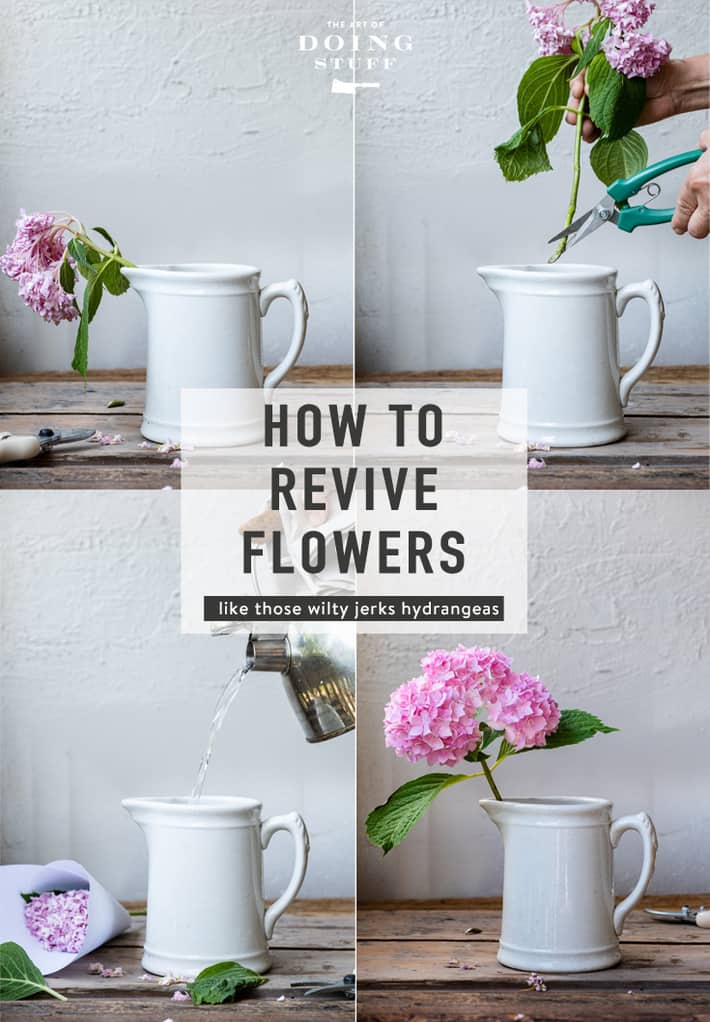



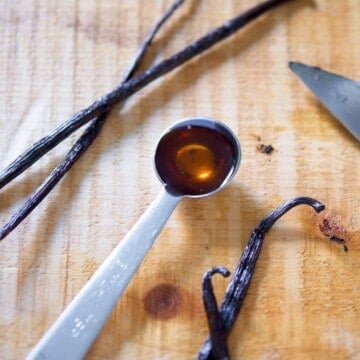

I love this!!
Thank you!!
I had no idea this is how it worked! Steaming hot water?!?! Who knew!?
I'm so glad to have this information! For the DIY cut flower food - is that for the entire vase of water or do you just add a tablespoon or so of that mixture to a vase to help keep the flowers fresh?
Full confession. I just eyeball it based on the size of the vase. I should add that info to the post! Thanks. It's about 1 tablespoon for a large (1 litre) vase. So if I just have a bud vase of water for example, I just add a sprinkle. ~ karen!
I would never have guessed flowers would perk up in hot water. Thanks, Karen! You're the best blogger on the internet: consistent, generous, and full of truly useful and unique ideas. :)
Hi Karen, What a great post. I love your poppies. They are one of my favorites but I have trouble growing them. Any hints? Thanks for the hot water tip. I haven't heard that one before. I could have probably saved a few roses doing that. Thanks for all your ideas & tips. I have learned a lot from you.
Excellent tips! My dahlia instructions say to put it in hot water after cutting, but I never knew why. So I don't often do it. Certainly haven't used this degree of hot water.
What is that beautiful orangish dahlia?!
Hi Leslie! Those are Alfred C dahlias. I love them. They're huge. ~ karen!
Haven't had time to do this yet but wanted to comment on YOU. I always get a morning smile, laugh, or inspiration from YOU. I've learned something new today and had to say thank you. I always cold water underwater cut and then recut already vased up flowers and thought I was so smart since it did work. I wouldn't have tried this if I had heard it from anyone else as it seems like it would slightly cook the little beauty. I normally cut basil and give it a 5 minute bath in cold water then wrap it in paper towel to store in veg bin of fridge. NEVER would I have put it in warm water - ever! But since you said to, I'm giving it a try since it is YOU.
Hi Mary! You're doing the right thing with your basil. Hot/warm water is just for flowers. And thank YOU! ~ karen
You are full of great, weird information! I bet you win at trivia. Who knew? Not really surprising, though, a hot bath always makes me feel better, too.
Thanks for the flower food recipe. I always try to remember to change the water in my vases, so I always run out of the stuff, even when I bought the flowers.
Keep those tips coming, please, and sorry about the cucumber beetles. Love your blog!
Wow great to know it’s only for flowers👌👏
You are my hero! I always bring in hydrangeas from the garden, knowing they will die within 24 hours, but I do it anyway! And this trick really worked!!! You made my day!
Also with the easy mayonaise - but its your fault when i put on a few kilos during winter! Ha ha
Your rock. Always have, always will.
There is another way to revive hydrangea blooms without handling boiling water.
To introduce myself, I am one of the authors of a guide to Fresh Cut Flowers called What Cut Flower is That? it is available as a PDF https://www.agrifutures.com.au/wp-content/uploads/publications/13-079.pdf
This book is recognized as the learning resource for Floristry colleges throughout Australia.
we consulted with two leading Post harvest specialists in writing this book which was financed by the Australian Government to educate florists and the cut flower industry.
The truth is, when you scald stems in this way it does cause a wonderful short term effect, however it also causes damage to the stems internally which in turn causes stem block followed by a break down of cells allowing them to rot. .
A more simple method is to fully immerse the flower heads in water for up to 6 to 8 hours, they will absorb the moisture into the flower head and stand up beautifully with an excellent vase life of a week or much more.
Hydrangea florets are the very tiny flowers in the centre of those big showy 'petals' which are really modified leaves. It is best to wait to pick the stems when at least 70% of the tiny florets are open, and even better when they mature and start to turn green or other stunning colours, this is why blooms picked in Autumn or late summer last so well without any fuss.
BTW, I have a somewhat similar trick for reviving lettuce (romaine is what I tried it with) Fill your sink with very hot water, dunk your sorry looking lettuce leave in, and wait for the miracle to happen. Just like with the boiling water for the hydrangea, the tip for which I will forever be grateful.
Karen rides again to the rescue!
Thank you so much for all your tips, your how tos and your self deprecating humour. Love it all..
Wonder if this will work on lilacs? There used to be an old abandoned farm across the street from my house with lots of overgrown lilac bushes and every year I’d hike through the plowed mud fields to grab a bunch and every year they’d be all wilted within minutes. Now the farm is gone. And the lilacs. Replaced by hundreds of ugly houses.... sigh. But I still love free lilacs!
Karen, totally off topic here. Do take a look at these bouquets that don't need reviving:
https://www.atlasobscura.com/articles/julie-simon-cakes?utm_source=Gastro+Obscura+Weekly+E-mail&utm_campaign=b2d3a8e029-GASTRO_EMAIL_CAMPAIGN_2020_07_14&utm_medium=email&utm_term=0_2418498528-b2d3a8e029-71019437&mc_cid=b2d3a8e029&mc_eid=523e58ddfa
And be sure to click on the links in the article to see her other creations.
Holy CRAP! ~ karen
Thank you for sharing that link. Truly incredible and delightful!
My daughter in law wanted all hydrangeas for her wedding day, after experimenting with several different methods, the best advice ever, right after cutting them from the garden , smash the stems with a hammer before putting in water, this allows for the most water absorption - worked like a charm, not one wilted flower on the table on a warm summer's night!
Dear Karen - I’m making my own wedding centrepieces. I did a practice run and they looked fabulous, but in less than 24 hours the hydrangeas in floral foam had wilted. I found your post when researching how to make them last longer! Will this work when using foam/oasis? And how long will the last after revived? This amateur is trying to work out the ideal time to make the arrangements for the big day!
Hi Siun. Hydrangeas are iffy at the best of times, so putting them in oasis is a bit of a risk. The oasis particles travel up the stem and can block water from flowing. :/ (you're using wet oasis, right?) Hydrangeas that have been revived can last anywhere from 2-5 days. It's kind of a crap shoot I'm afraid. ~ karen!
Thanks for the advice and speedy response. Yep, I used wet oasis. Sounds like I should be leaving it to the last possible minute to do the arranging if using foam!